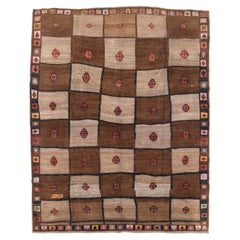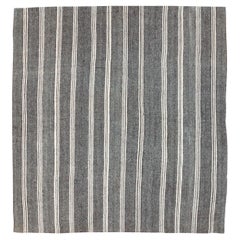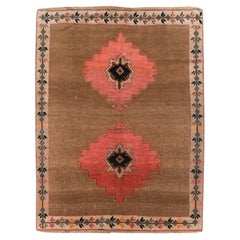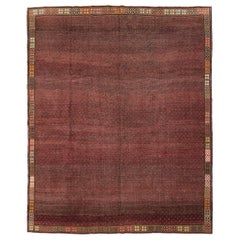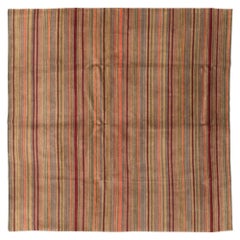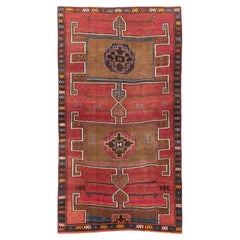Galerie Shabab Turkish Rugs
to
119
Width
to
Length
to
744
284
6
250
34
23
12
10
7
5
1
1
742
290
156
539
13
1
3
8
13
1
1
1,031
1,002
22
21
9
1,034
1,034
1,033
1,033
1,030
1,030
1,002
1,002
28
Galerie Shabab Collection Mid-20th Century Turkish Tribal Room Size Carpet
Located in New York, NY
A vintage Turkish Anatolian tribal room size carpet handmade during the Mid-20th Century.
Measures: 9' 1" x 11' 6".
Category
Mid-20th Century Turkish Tribal Turkish Rugs
Materials
Wool
Mid-20th Century Turkish Flatweave Small Room Size Rug
Located in New York, NY
A vintage Turkish flatweave Kilim small square room size carpet handmade during the Mid-20th Century.
Measures: 8' 9" x 9' 4".
Category
Mid-20th Century Turkish Minimalist Turkish Rugs
Materials
Goat Hair
Galerie Shabab Collection Mid-20th Century Turkish Anatolian Room Size Carpet
Located in New York, NY
A vintage Turkish Anatolian room size carpet handmade during the Mid-20th Century.
Measures: 8' 11" x 12' 0".
Category
Mid-20th Century Turkish Rustic Turkish Rugs
Materials
Wool
Galerie Shabab Collection Mid-20th Century Turkish Anatolian Room Size Carpet
Located in New York, NY
A vintage Turkish Anatolian room size carpet handmade during the mid-20th century.
Measures: 8' 6" x 10' 4".
Category
Mid-20th Century Turkish Rustic Turkish Rugs
Materials
Wool
Galerie Shabab Collection Contemporary Handmade Turkish Room Size Carpet
Located in New York, NY
A modern Turkish room size carpet handmade during the 21st century.
Measures: 8' 10" x 11' 3".
Category
21st Century and Contemporary Turkish Mid-Century Modern Turkish Rugs
Materials
Wool
Mid-20th Century Turkish Tribal Room Size Carpet
Located in New York, NY
A vintage Turkish Anatolian long room size carpet handmade during the Mid-20th Century.
Measures: 8' 3" x 14' 10".
Category
Mid-20th Century Turkish Tribal Turkish Rugs
Materials
Wool
Mid-20th Century Turkish Flatweave Large Room Size Rug
Located in New York, NY
A vintage Turkish flatweave Kilim large room size carpet handmade during the Mid-20th Century.
Measures: 11' 11" x 15' 0".
Category
Mid-20th Century Turkish Rustic Turkish Rugs
Materials
Wool
Galerie Shabab Collection Handmade Turkish Contemporary Room Size Carpet
Located in New York, NY
A modern Turkish room size carpet handmade during the 21st century.
Measures: 8' 10" x 11' 7"
Category
21st Century and Contemporary Turkish Modern Turkish Rugs
Materials
Wool
Galerie Shabab Collection Modern Handmade Turkish Flatweave Kilim Room Size Rug
Located in New York, NY
A contemporary Turkish flatweave Kilim room size carpet handmade during the 21st century in cream and light blue.
Measures: 9' 5" x 13' 6".
Category
21st Century and Contemporary Turkish Modern Turkish Rugs
Materials
Wool
Galerie Shabab Collection Contemporary Handmade Turkish Room Size Carpet
Located in New York, NY
A modern Turkish room size carpet handmade during the 21st century.
Measures: 8' 10" x 12' 3".
Category
21st Century and Contemporary Turkish Modern Turkish Rugs
Materials
Wool
Galerie Shabab Collection Mid-20th Century Turkish Flatweave Kilim Room Size Rug
Located in New York, NY
A vintage Turkish flatweave Kilim room size carpet handmade during the Mid-20th Century.
Measures: 10' 2" x 13' 10".
Category
Mid-20th Century Turkish Modern Turkish Rugs
Materials
Wool
Mid-20th Century Turkish Flatweave Kilim Large Carpet
Located in New York, NY
A vintage Turkish flatweave Kilim large carpet handmade during the Mid-20th Century.
Measures: 13' 4" x 16' 4".
Category
Mid-20th Century Turkish Rustic Turkish Rugs
Materials
Wool
Galerie Shabab Collection Mid-20th Century Turkish Flatweave Kilim Runner
Located in New York, NY
A vintage Turkish flatweave Kilim runner handmade during the Mid-20th Century.
Measures: 2' 9" x 13' 5".
Category
Mid-20th Century Turkish Modern Turkish Rugs
Materials
Wool
Mid-20th Century Turkish Flatweave Kilim Room Size Rug
Located in New York, NY
A vintage Turkish flatweave Kilim room size carpet handmade during the Mid-20th Century.
Measures: 9' 2" x 12' 0".
Category
Mid-20th Century Turkish Rustic Turkish Rugs
Materials
Wool
Galerie Shabab Collection Mid-20th Century Turkish Flatweave Kilim Room Size Rug
Located in New York, NY
A vintage Turkish flatweave Kilim room Size carpet handmade during the Mid-20th Century.
Measures: 10' 0" x 13' 0".
Category
Mid-20th Century Turkish Rustic Turkish Rugs
Materials
Wool
Mid-20th Century Turkish Flatweave Large Room Size Rug
Located in New York, NY
A vintage Turkish flatweave Kilim large room size carpet handmade during the Mid-20th Century.
Measures: 12' 2" x 15' 0".
Category
Mid-20th Century Turkish Modern Turkish Rugs
Materials
Wool
Mid-20th Century Turkish Flatweave Kilim Room Size Rug
Located in New York, NY
A vintage Turkish flatweave Kilim room size carpet handmade during the Mid-20th Century.
Measures: 8' 4" x 12' 0".
Category
Mid-20th Century Turkish Rustic Turkish Rugs
Materials
Wool
Mid-20th Century Turkish Anatolian Room Size Rug
Located in New York, NY
A vintage Turkish Anatolian tribal room size carpet handmade during the mid-20th century.
Measures: 9' 1" x 15' 3".
Category
Mid-20th Century Turkish Tribal Turkish Rugs
Materials
Wool
Galerie Shabab Collection Moroccan Inspired Modern Turkish Room Size Carpet
Located in New York, NY
A modern Turkish large carpet with tassels and braided fringes. Handmade during the 21st century, this carpet is inspired by vintage Moroccan carpets from the Mid-20th Century period...
Category
21st Century and Contemporary Turkish Modern Turkish Rugs
Materials
Wool
Galerie Shabab Collection Moroccan Inspired Contemporary Turkish Large Carpet
Located in New York, NY
A modern Turkish large carpet with tassels and braided fringes. Handmade during the 21st century, this carpet is inspired by vintage Moroccan carpets from the mid-20th century period...
Category
21st Century and Contemporary Turkish Modern Turkish Rugs
Materials
Wool
Galerie Shabab Collection Contemporary Handmade Turkish Square Oversize Carpet
Located in New York, NY
A modern Turkish square oversize carpet handmade during the 21st century.
Measures: 18' 1" x 21' 9".
Category
21st Century and Contemporary Turkish Modern Turkish Rugs
Materials
Wool
Mid-20th Century Turkish Art Deco Style Room Size Rug
Located in New York, NY
A vintage Turkish Art Deco style room size carpet handmade during the mid-20th century.
Measures: 9' 10" x 13' 7".
Category
Mid-20th Century Turkish Art Deco Turkish Rugs
Materials
Wool
Galerie Shabab Collection Mid-20th Century Handmade Turkish Tribal Room Size Rug
Located in New York, NY
A vintage Turkish Anatolian tribal room size carpet handmade during the Mid-20th Century.
Measures: 9' 11" x 14' 3".
Category
Mid-20th Century Turkish Tribal Turkish Rugs
Materials
Wool
Galerie Shabab Collection Vintage Turkish Flatweave Kilim Room Size Carpet
Located in New York, NY
A vintage Turkish flatweave Kilim room size carpet handmade during the Mid-20th Century.
Measures: 8' 1" x 12' 5".
Category
Mid-20th Century Turkish Rustic Turkish Rugs
Materials
Wool
Vintage Turkish Flatweave Kilim Oversize Carpet
Located in New York, NY
A vintage Turkish flatweave Kilim oversize carpet handmade during the Mid-20th Century.
Measures: 14' 5" x 19' 9".
Category
Mid-20th Century Turkish Rustic Turkish Rugs
Materials
Hemp
Galerie Shabab Collection New Handmade Turkish Zebra Print Room Size Carpet
Located in New York, NY
A contemporary Turkish zebra print large room size carpet handmade during the 21st century.
Measures: 10' 1" x 14' 9".
Category
21st Century and Contemporary Turkish Modern Turkish Rugs
Materials
Wool
Galerie Shabab Collection Mid-20th Century Handmade Turkish Tribal Gallery Rug
Located in New York, NY
A vintage Turkish Anatolian tribal gallery carpet handmade during the Mid-20th Century.
Measures: 6' 4" x 11' 7".
Category
Mid-20th Century Turkish Tribal Turkish Rugs
Materials
Wool
Galerie Shabab Collection Mid-20th Century Turkish Tribal Room Size Carpet
Located in New York, NY
A vintage Turkish Anatolian tribal room size carpet handmade during the Mid-20th Century.
Measures: 9' 11" x 12' 10".
Category
Mid-20th Century Turkish Tribal Turkish Rugs
Materials
Wool
Contemporary Handmade Turkish Flatweave Kilim Room Size Carpet
Located in New York, NY
A contemporary Turkish flatweave Kilim room size carpet handmade during the 21st century.
Measures: 9' 5" x 12' 1".
Category
21st Century and Contemporary Turkish Modern Turkish Rugs
Materials
Wool
Colorful Contemporary Turkish Flatweave Kilim Room Size Carpet
Located in New York, NY
A colorful modern Turkish flatweave Kilim room size carpet handmade during the 21st century.
Measures: 9' 9" x 12' 1".
Category
21st Century and Contemporary Turkish Modern Turkish Rugs
Materials
Wool
Contemporary Handmade Turkish Room Size Carpet
Located in New York, NY
A contemporary Turkish room size carpet handmade during the 21st century.
Measures: 9' 7" x 11' 3".
Category
21st Century and Contemporary Turkish Modern Turkish Rugs
Materials
Wool
Modern Rustic Handmade Turkish Flatweave Kilim Room Size Carpet
Located in New York, NY
A modern rustic Turkish flatweave Kilim room size carpet handmade during the 21st century.
Measures: 10' 6" x 14' 9".
Category
21st Century and Contemporary Turkish Modern Turkish Rugs
Materials
Wool
Mid-20th Century Handmade Turkish Flatweave Kilim Room Size Carpet
Located in New York, NY
A vintage Turkish flatweave Kilim room size carpet handmade during the mid-20th century.
Measures: 10' 8" x 14' 1".
Category
Mid-20th Century Turkish Rustic Turkish Rugs
Materials
Wool
Mid-20th Century Handmade Turkish Flatweave Kilim Room Size Carpet
Located in New York, NY
A vintage Turkish flatweave Kilim room size carpet handmade during the mid-20th century.
Measures: 10' 7" x 14' 1".
Category
Mid-20th Century Turkish Rustic Turkish Rugs
Materials
Wool
Mid-20th Century Handmade Turkish Flatweave Kilim Room Size Carpet
Located in New York, NY
A vintage Turkish flatweave Kilim room size carpet handmade during the mid-20th century.
Measures: 10' 1" x 13' 2".
Category
Mid-20th Century Turkish Rustic Turkish Rugs
Materials
Wool
Mid-20th Century Handmade Turkish Flatweave Kilim Room Size Carpet
Located in New York, NY
A vintage Turkish flatweave Kilim room size carpet handmade during the mid-20th century.
Measures: 11' 3" x 15' 1".
Category
Mid-20th Century Turkish Rustic Turkish Rugs
Materials
Wool
Mid-20th Century Handmade Turkish Flatweave Kilim Room Size Carpet
Located in New York, NY
A vintage Turkish flatweave Kilim room size carpet handmade during the mid-20th century.
Measures: 11' 0" x 14' 0".
Category
Mid-20th Century Turkish Rustic Turkish Rugs
Materials
Wool
Persian Inspired New Turkish Flatweave Kilim Large Room Size Carpet
Located in New York, NY
A new Turkish flatweave Kilim large room size carpet handmade during the 21st century inspired by vintage Persian Kilims.
Measures: 12' 0" x 14'...
Category
21st Century and Contemporary Turkish Modern Turkish Rugs
Materials
Wool
Contemporary Turkish Flatweave Kilim Room Size Carpet in Cream and Dark Brown
Located in New York, NY
A contemporary Turkish flatweave Kilim room size carpet handmade during the 21st century.
Measures: 9' 10" x 13' 2".
Category
21st Century and Contemporary Turkish Scandinavian Modern Turkish Rugs
Materials
Wool
$7,300 Sale Price
20% Off
Contemporary Turkish Flatweave Kilim Room Size Carpet in Cream and Dark Brown
Located in New York, NY
A contemporary Turkish flatweave Kilim room size carpet handmade during the 21st century.
Measures: 9' 11" x 12' 11".
Category
21st Century and Contemporary Turkish Modern Turkish Rugs
Materials
Wool
$7,300 Sale Price
20% Off
Modern Rustic Handmade Turkish Flatweave Kilim Room Size Carpet
Located in New York, NY
A new rustic modern Turkish flatweave Kilim room size carpet handmade during the 21st century.
Measures: 10' 8" x 13' 3".
Category
21st Century and Contemporary Turkish Rustic Turkish Rugs
Materials
Wool
Rustic Handmade Turkish Flatweave Kilim Room Size Carpet
Located in New York, NY
A new rustic Turkish flatweave Kilim room size carpet handmade during the 21st century.
Measures: 10' 9" x 13' 2".
Category
21st Century and Contemporary Turkish Rustic Turkish Rugs
Materials
Wool
Contemporary Handmade Turkish Flatweave Kilim Room Size Carpet
Located in New York, NY
A modern Turkish flatweave Kilim room size carpet handmade during the 21st century.
Measures: 11' 2" x 14' 2".
Category
21st Century and Contemporary Turkish Modern Turkish Rugs
Materials
Wool
Mid-20th Century, Handmade Turkish Flatweave Kilim Room Size Carpet
Located in New York, NY
A vintage Turkish flatweave Kilim room size carpet handmade during the mid-20th century.
Measures: 10' 0" x 13' 0".
Category
Mid-20th Century Turkish Modern Turkish Rugs
Materials
Wool
Contemporary Handmade Turkish Flatweave Kilim Room Size Carpet
Located in New York, NY
A modern Turkish flatweave Kilim room size carpet handmade during the 21st century.
Measures: 10' 0" x 11' 6".
Category
21st Century and Contemporary Turkish Modern Turkish Rugs
Materials
Wool
Mid-20th Century Handmade Turkish Flatweave Kilim Room Size Carpet
Located in New York, NY
A vintage Turkish flatweave Kilim room size carpet handmade during the mid-20th century.
Measures: 10' 7" x 13' 0".
Category
Mid-20th Century Turkish Rustic Turkish Rugs
Materials
Wool
Mid-20th Century Handmade Turkish Flatweave Kilim Room Size Carpet
Located in New York, NY
A vintage Turkish flatweave Kilim room size carpet handmade during the mid-20th century.
Measures: 10' 4" x 12' 10".
Category
Mid-20th Century Turkish Minimalist Turkish Rugs
Materials
Wool
Contemporary Handmade Turkish Flatweave Kilim Square Room Size Carpet
Located in New York, NY
A vintage Turkish flatweave Kilim square room size carpet handmade during the 21st century.
Measures: 10' 5" x 11' 8".
Category
21st Century and Contemporary Turkish Tribal Turkish Rugs
Materials
Wool
Contemporary Handmade Turkish Flatweave Kilim Patchwork Style Room Size Carpet
Located in New York, NY
A modern Turkish flatweave Kilim patchwork style room size carpet handmade during the 21st century incorporating remnants of vintage Kilim rugs from the mid-20th century period.
M...
Category
21st Century and Contemporary Turkish Modern Turkish Rugs
Materials
Wool
Contemporary Handmade Turkish Flatweave Kilim Patchwork Style Room Size Carpet
Located in New York, NY
A modern Turkish flatweave Kilim patchwork style room size carpet handmade during the 21st century incorporating remnants of vintage Kilim rugs from the mid-20th century period.
M...
Category
21st Century and Contemporary Turkish Modern Turkish Rugs
Materials
Wool
Contemporary Handmade Turkish Flatweave Kilim Patchwork Style Room Size Carpet
Located in New York, NY
A modern Turkish flatweave Kilim patchwork style room size carpet handmade during the 21st century incorporating remnants of vintage Kilim rugs from the mid-20th century period.
M...
Category
21st Century and Contemporary Turkish Modern Turkish Rugs
Materials
Wool
Contemporary Handmade Turkish Flatweave Kilim Patchwork Style Room Size Carpet
Located in New York, NY
A modern Turkish flatweave Kilim patchwork style room size carpet handmade during the 21st century incorporating remnants of vintage Kilim rugs from the mid-20th century period.
M...
Category
21st Century and Contemporary Turkish Modern Turkish Rugs
Materials
Wool
Contemporary Handmade Turkish Flatweave Kilim Room Size Carpet
Located in New York, NY
A modern Turkish flatweave Kilim room size carpet handmade during the 21st century.
Measures: 9' 0" x 12' 0".
Category
21st Century and Contemporary Turkish Modern Turkish Rugs
Materials
Wool
Late 20th Century Handmade Turkish Flatweave Kilim Oversize Carpet
Located in New York, NY
A vintage Turkish flatweave Kilim oversize carpet handmade during the late 20th century.
Measures: 13' 1" x 20' 4"
Category
Late 20th Century Turkish Modern Turkish Rugs
Materials
Wool
Contemporary Handmade Turkish Flatweave Kilim Oversize Carpet
Located in New York, NY
A modern Turkish flatweave Kilim oversize carpet handmade during the 21st century.
Measures: 14' 7" x 19' 9".
Category
21st Century and Contemporary Turkish Modern Turkish Rugs
Materials
Wool
Mid-20th Century Handmade Turkish Flatweave Kilim Room Size Carpet
Located in New York, NY
A vintage Turkish flatweave Kilim room size carpet handmade during the mid-20th century.
Measures: 9' 11" x 13' 3".
Category
Mid-20th Century Turkish Rustic Turkish Rugs
Materials
Wool
Mid-20th Century Handmade Turkish Flatweave Kilim Room Size Carpet
Located in New York, NY
A vintage Turkish flatweave Kilim room size carpet handmade during the mid-20th century.
Measures: 9' 11" x 13' 3".
Category
Mid-20th Century Turkish Rustic Turkish Rugs
Materials
Wool
Mid-20th Century Handmade Turkish Flatweave Kilim Room Size Carpet
Located in New York, NY
A vintage Turkish flatweave Kilim room size carpet handmade during the mid-20th century.
Measures: 10' 0" x 13' 11".
Category
Mid-20th Century Turkish Modern Turkish Rugs
Materials
Wool
Mid-20th Century Handmade Turkish Flatweave Kilim Room Size Carpet
Located in New York, NY
A vintage Turkish flatweave Kilim room size carpet handmade during the mid-20th century.
Measures: 8' 7" x 11' 6".
Category
Mid-20th Century Turkish Modern Turkish Rugs
Materials
Wool
Mid-20th Century Handmade Turkish Flatweave Kilim Small Room Size Carpet
Located in New York, NY
A vintage Turkish flatweave Kilim small room size carpet handmade during the mid-20th century.
Measures: 7' 7" x 10' 5".
Category
Mid-20th Century Turkish Tribal Turkish Rugs
Materials
Goat Hair
